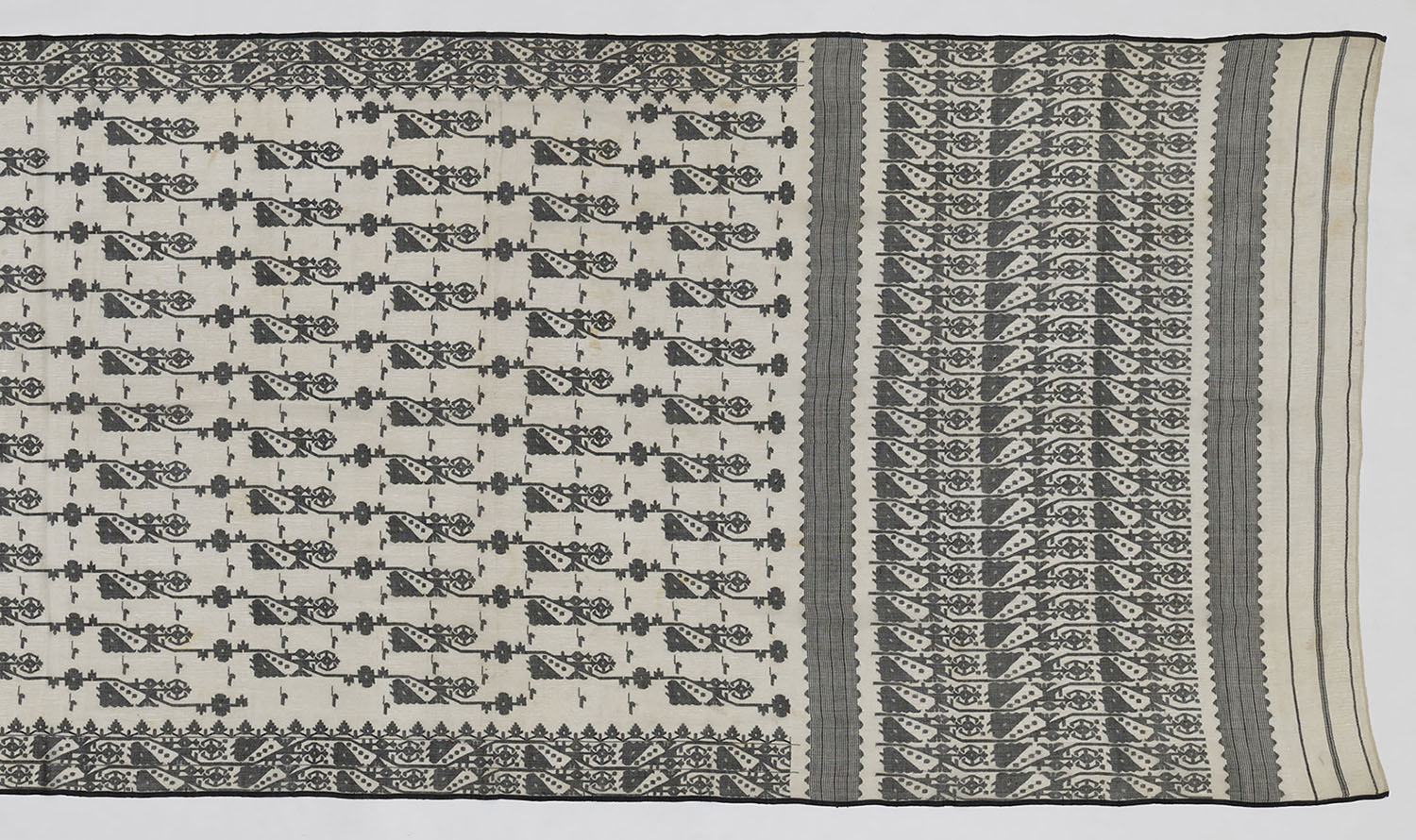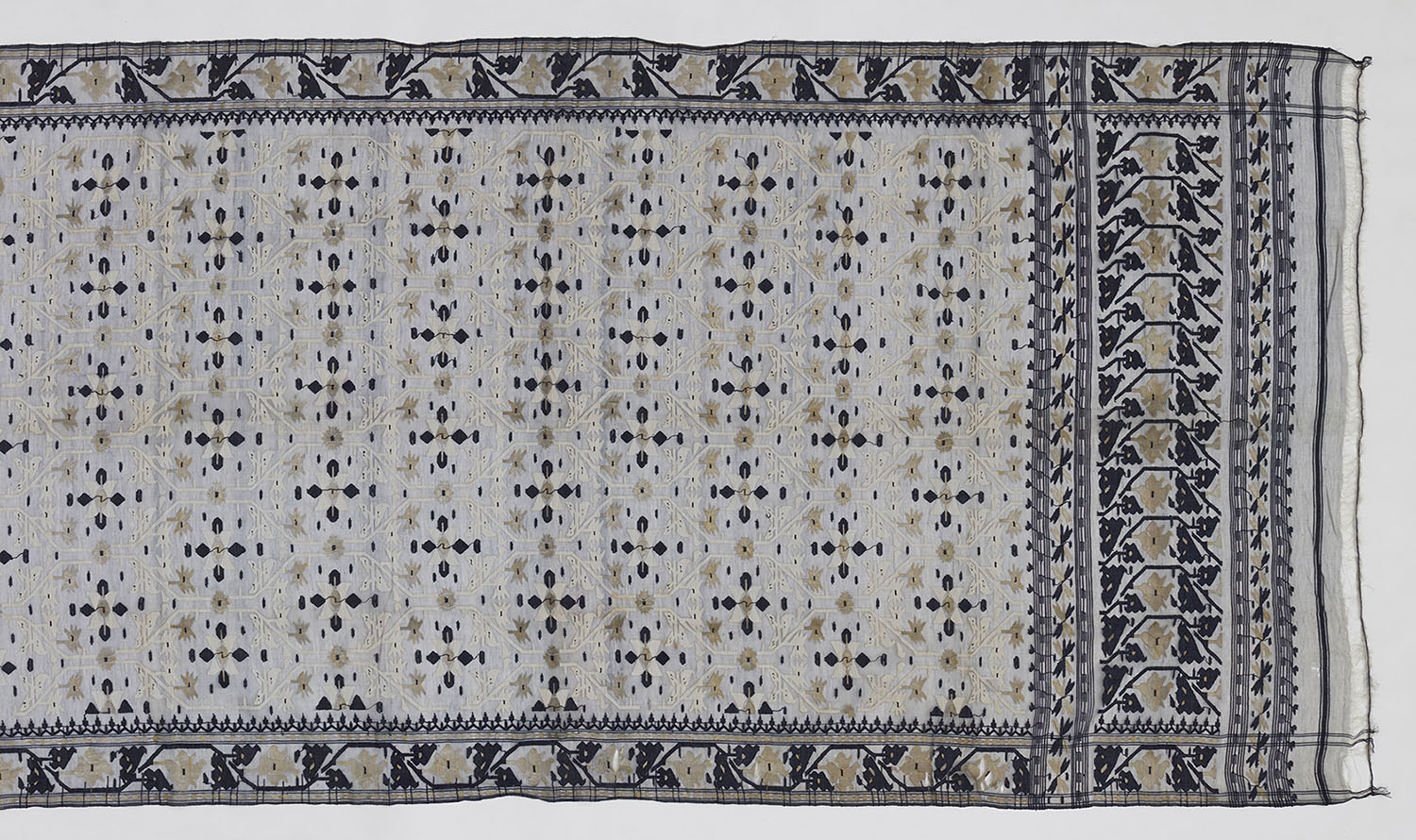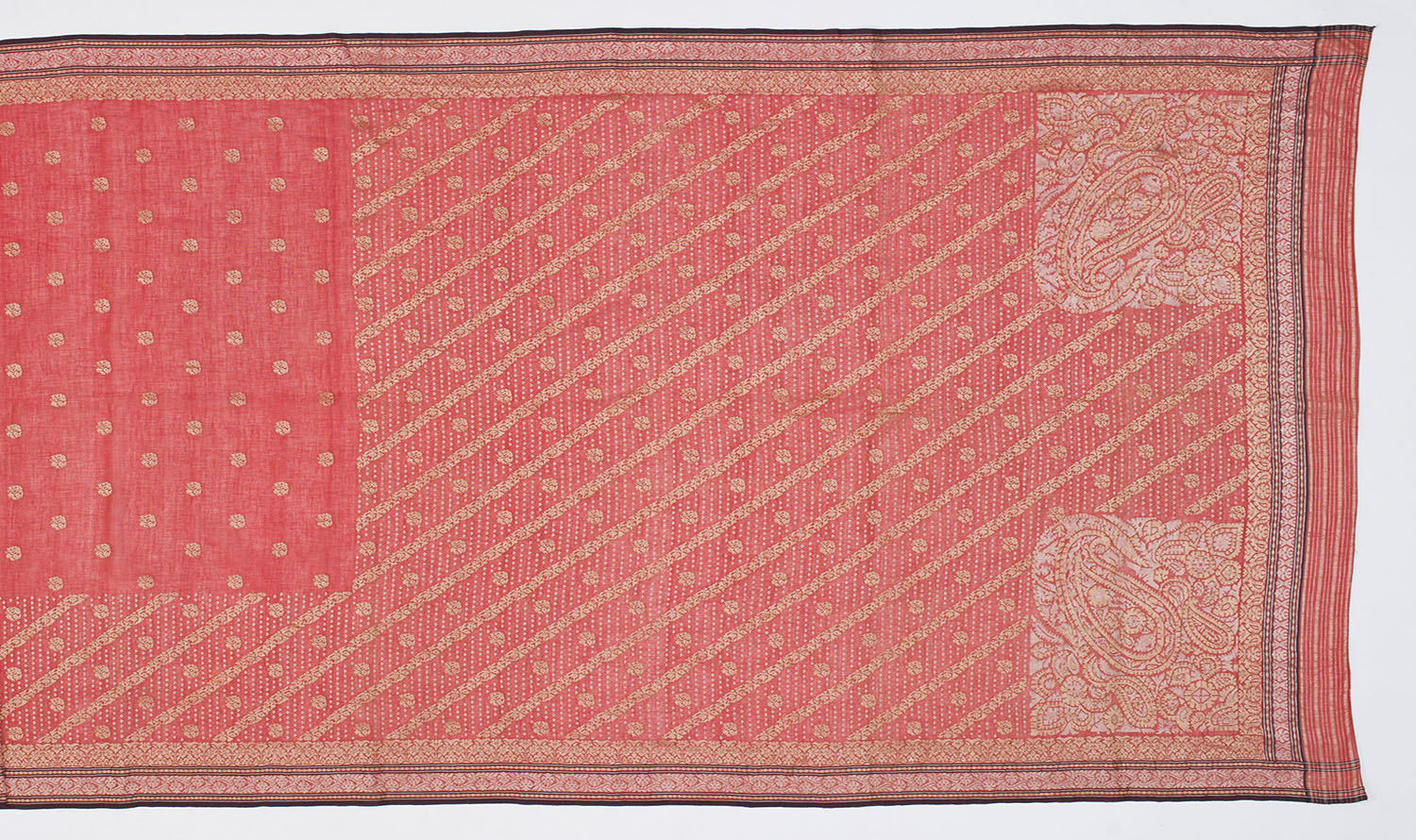ARTICLE
Jamdani
Historically the fibres of a particular variant of tree cotton (Gossypium arboreum) known as phuti karpas (G. arboreum var. neglecta) have been used to make the muslin for jamdani weaves. Now extinct, the plant is said to have grown only along the banks of the Meghna river in and around Dhaka, and its fibres were especially delicate and short, rendering it unsuitable to spin into ordinary cotton yarn. The raw cotton was cleaned using a fine comb fashioned from the jawbone of a local fish, and processed in a number of steps devised specifically to spin this variety of cotton. These fibres had the peculiar property of shrinking rather than expanding on absorbing moisture — making them stronger and thereby possible to spin into yarn when wet. So the yarn was spun in humid conditions, during the early mornings and evenings, and the spinners worked surrounded by bowls of water, on the riverside, or on boats moored on the river. Girls and young women were considered best suited for the task because of their nimble fingers and sharp vision as the fibres were too fine to be worked by older people. From the yarn spun in these specialised conditions, weavers of the region were able to create a fabric of such unusual lightness that it earned epithets such as baft hawa — Persian and Urdu for ‘woven air’ — and led to myths that it was the creation of mermaids or fairies on the Meghna river.
Whilst the muslin yarn for jamdani was traditionally spun by Hindus, some of whom wove plain muslin, jamdani weaving has been done largely by Muslims of the Julaha weaving community, who are also known as jamdani tantis, or weavers (from the Odia for ‘loom’ — tanta). Each part of the intricate spinning and weaving process was the specialisation of a different local community or group. At various points in subsequent centuries, the tradition travelled to other parts of India with the movement of the artisans.
While phuti karpas cotton is no longer cultivated, jamdani weavers continue to use traditional techniques with regular cotton yarn. In order to make the yarn strong enough to be stretched and woven on the loom, it is first washed and then sized with rice starch, for which a gruel of the kalama variety of rice is typically used. The wet yarn is wound onto the natai, a cylindrical bamboo frame, and allowed to dry. The warp thread is then stretched onto a pit loom with a perforated bamboo reed frame; the weft thread is drawn through this frame.
The loom is operated by two weavers — generally a master weaver and an apprentice — seated side by side. A sheet of paper with the patterns and motifs sketched out is often held under the warp for reference. While the ground weft is passed back and forth using a shuttle, or maku, the motifs and patterns are simultaneously created by using extra weft, or supplementary weft, thread from its own spool according to the predefined pattern. Each motif is rendered by hand using a special pointed tool made of ox horn, called kandul or kandi, or bamboo sticks sharpened into needles, to interlace the extra weft thread through selected parts of the warp in a slow, meticulous process. This is done row by row, alternating with the regular weft thread, with an extremely high number of repetitions required to achieve even a moderately high thread count. The yarn used for the extra weft of the motifs is typically thicker than that of the rest of the fabric. Sometimes a Jacquard loom is used to partly automate the process, though it is unable to achieve the intricacy and quality of the finest jamdani.
While the supplementary weft technique is also used in brocade, leading to jamdani sometimes being classified as a form of cotton brocade, these supplementary-weft motifs in jamdani are not standardised using prearranged heddles as in a Jacquard loom, but individually introduced into the warp by hand. In order to achieve various motifs and patterns in this way, weavers have passed down counting techniques through generations using mnemonic devices or illustrations.
Until the eighteenth century, jamdani weaves were typically made in white or light colours and used for a variety of garments, whereas modern jamdani weaves are available in a wide range of colours and yarns and are typically used for saris. White jamdani saris generally comprise an unbleached cotton ground with designs rendered in bleached white cotton; others may feature white designs on a pastel-coloured ground, or colourful designs on a dark ground. More festive jamdanis are also made from coloured grounds embellished with zari work brocaded along with cotton design threads, or solely with zari work.
Basic jamdani patterns can be divided into three types — butidar, or floral designs; linear diagonals or terchi; and a network of patterns across the entire ground of the cloth, which is referred to as jhalar or jala. Developed alongside other Persianate arts in the Mughal empire, some common jamdani motifs are derived from fruits, flora, fauna and sweets and include pati (petal), bagher paa (tiger’s paw), chameli (jasmine), shandesh (sweets), ashrafi (gold coin), kainchi (scissors), panna hajar (thousand emeralds), kalka (paisley), tesra (diagonal patterns), duria (polka dots) and charkona (rectangular motifs). These motifs may adorn the border of the sari or cover the central field in various patterns. Sometimes the pallu of the sari is also decorated with elaborate motifs such as angurlata or grapevine.
Patronised by imperial courts and traded internationally, the jamdani textile was coveted for its fineness and intricacy until the eighteenth century, when the flourishing muslin industry in Dhaka declined. With the Industrial Revolution (c. 1760–1840) in Britain, cheap mill cotton was imported and sold in the Indian market. Dhaka was replaced with Egypt and America for the colonial administration’s raw cotton needs; Bengali weavers found the imported machine-made yarn too thick and unsuitable to work with. Even as they continued to produce coarser jamdani from these threads in less intricate patterns, patronage for high-quality jamdani declined as feudalism weakened in colonial Bengal. Muslin cotton cultivation and jamdani weaving in Dhaka came to a grinding halt with the British enforcing brutal bans on local cloth production.
In the early twentieth century, the production of indigenous khadi cotton received impetus from the Indian Swadeshi Movement, which called for a boycott of imported British goods and strengthened the domestic production of textiles. But while coarse khadi became a symbol of India’s self-sufficiency, locally produced muslin received no such attention. In the aftermath of the Partition in 1947, the cultivation of muslin cotton and jamdani production suffered another setback as Muslim weavers and Hindu yarn-spinners moved across newly created borders between West Bengal, India, and East Pakistan (present-day Bangladesh). In newly independent India, even as elected governments championed khadi for several decades, the historic centre of the jamdani — East Pakistan, later Bangladesh — continued to suffer from the after-effects of colonialism.
The Partition led to regional variations of jamdani, such as the Tangail jamdani, which was made in the district of Nadia in West Bengal by weavers who had migrated from Tangail in Bangladesh. Tangail jamdani saris are distinguished from other jamdanis by their special finishing techniques and border designs. Outside the important weaving centres in Bengal, jamdani has also been produced in the town of Tanda in Uttar Pradesh, home to a delicate white-on-white style of jamdani patterning that resembles chikankari embroidery. The industry in Tanda is said to have been established under the patronage of Wajid Ali Shah (r. 1847–56), the nawab of the Awadh kingdom, in present-day Faizabad and Lucknow. Previously, the seventeenth century also saw the development of Uppada jamdani saris in present-day Andhra Pradesh, which were woven exclusively for the royal families of Pithapuram, Bobilli and Venkatagiri. Varanasi in Uttar Pradesh also has a tradition of cotton-on-silk jamdani, known as Banarasi jamdani.
The techniques associated with Uppada jamdani were revived by the Weavers Service Centre, Vijayawada in 1985. After the liberalisation of the Indian economy in the early 1990s, the government encouraged muslin production to earn foreign revenue from the export of luxury items such as the jamdani. Around this time, the muslin weaving industry was revived in Kalna, West Bengal, where weavers from around Dhaka had settled following the Partition; as well as in Nabadwip in the Nadia district of West Bengal. Simultaneously, mass-produced but less fine jamdani also became the preferred sari textile amongst Bengali women. These innovations, along with its growing popularity as a fine sari material, established the jamdani as a commercially viable textile industry in the region.
The districts of Sonargaon and Rupshi in Bangladesh, as well as Nadia and Purba Bardhaman in West Bengal, are known for their jamdani industries today. In Kalna, Purba Bardhman, master weaver Jyotish Debnath and his son Rajib specialise in weaving fine muslin jamdani using only hand-spun cotton and historical techniques. Master weaver Biren Basak from the village of Phulia in the district of Nadia specialises in weaving narrative scenes using the jamdani technique. The spinning of fine yarn was revived by weaver Kalicharan Sharma from Murshidabad. Rabindranath Saha, a thirteenth-generation master weaver, invented a machine that could spin super-fine thread required for the 500-count jamdani and won the Sant Kabir national award for his innovation in 2004.
Jamdani weaving is typically done using only cotton yarn, but contemporary variations have incorporated other materials such as nylon, silk, and cotton-silk blends. In 2009, the Uppada jamdani saris received a Geographical Indication (GI) tag from the Indian government. In 2013, UNESCO added the jamdani tradition of Dhaka to its list of intangible cultural heritage. In 2014, the Dhaka-based Bengal Muslin project led by Saiful Islam was founded to research, revive and support Dhaka muslin textile traditions, including jamdani weaving. Bangladesh recognised the jamdani as a locally produced fabric with the first ever GI tag for the country in 2016. In the United Kingdom, the non-profit Muslin Trust’s Jamdani Project supports jamdani production in Bangladesh by commissioning weavers and funding the training of young weavers in the jamdani technique.
A luxury item today, samples of traditionally made jamdani textile are housed in museums across the world including the Philadelphia Museum of Art, USA; National Museums Liverpool, UK; the Cooper-Hewitt Smithsonian Design Museum, New York; and theVictoria and Albert Museum, London.
Bibliography
Bengal Muslin. “Project Background, Mission & Goals.” Accessed August 9, 2024. https://bengalmuslin.com/background-mission/.
Chen, Martha Alter. “Kantha and Jamdani.” India International Quarterly 11, no. 4 (1984): 45–62.
Gorvett, Zaria. “The Ancient Fabric that No One Knows How to Make.” BBC, March 17, 2021. https://www.bbc.com/future/article/20210316-the-legendary-fabric-that-no-one-knows-how-to-make.
Hiremath, Aloka, and Jaya Jaitley. “Centres of Jamdani Weaving.” Dastkari Haat Samiti. 2017. https://artsandculture.google.com/exhibit/0QIiFh-7cuPYIA.
Hiremath, Aloka, and Jaya Jaitley. “The Process of Jamdani Weaving.” Dastkari Haat Samiti. 2017. Accessed June 12, 2024. https://artsandculture.google.com/exhibit/the-process-of-jamdani-weaving-dastkari-haat-samiti/RgIiiiLe46DcLA?hl=en.
Injiri. “Quietness of Jamdani.” Techniques: Jamdani. May 14, 2020. Accessed August 7, 2024. https://www.injiri.co.in/techniques/jamdani/.
Islam, Saiful. “Today’s Muslin: The Second Coming.” Muslin: Our Story. Dhaka: Drik Picture Library, 2016.
Islam, Khademul. “The Story of Dhaka Muslin.” AramcoWorld. May/June 2016. https://www.aramcoworld.com/Articles/May-2016/Our-Story-of-Dhaka-Muslin.
“Jamdani: The Art of Exquisite Textiles from Bengal and Bangladesh.” AbirPothi, September 1, 2023. Accessed August 7, 2024. https://abirpothi.com/jamdani-the-art-of-exquisite-textiles-from-bengal-and-bangladesh/.
Muslin Trust. “Jamdani Project.” Accessed 9 August, 2024. https://muslintrust.org/jamdani-project/.
Naidu, T. Appala. “Of Uppada and the Weaving Skills of Girls.” The Hindu, November 17, 2020. https://www.thehindu.com/news/national/andhra-pradesh/of-uppada-and-the-weaving-skills-of-girls/article33111275.ece.
Peepul Tree World. “The Marvelous Art of Jamdani Weaving.” Video, September 27, 2022. https://www.youtube.com/watch?v=8xi6kqe7jy4.
Purushu Arie. “Jamdani and Brocade Weaving at Banaras.” Blog. August 18, 2011. Accessed August 8, 2024. https://purushu.com/2011/08/banarasi-silk-jamdani-and-brocade.html.
Rashid, Salfur, and ICHCAP. “Jamdani: The Art of Weaving.” Google Arts & Culture. 2017. Accessed on June 12, 2024. https://artsandculture.google.com/exhibit/jamdani-the-art-of-weaving-ichcap/ygIiKvXXi00LLg?hl=en.
Saiful Islam. “Muslin: Our Story.” Garland Magazine. April 20, 2016. Accessed August 8, 2024. https://garlandmag.com/threads/muslin-story-saiful-islam/.
Sonia Ashmore. “Weaving into the Future.” Selvedge. June 23, 2016. Accessed August 7, 2024. https://www.selvedge.org/blogs/selvedge/weaving-into-the-future?_pos=17&_sid=4f56cc832&_ss=r.
“The Joy of Jamdani.” Selvedge. July 15, 2017. Accessed August 7, 2024. https://www.selvedge.org/blogs/selvedge/the-joy-of-jamdani?_pos=11&_sid=4f56cc832&_ss=r.
Tsang de Lyster, Sharon. “The Delights of Jamdani Weaving.” The Textile Atlas. Accessed September 7, 2021. https://www.thetextileatlas.com/craft-stories/jamdani-weaving.










